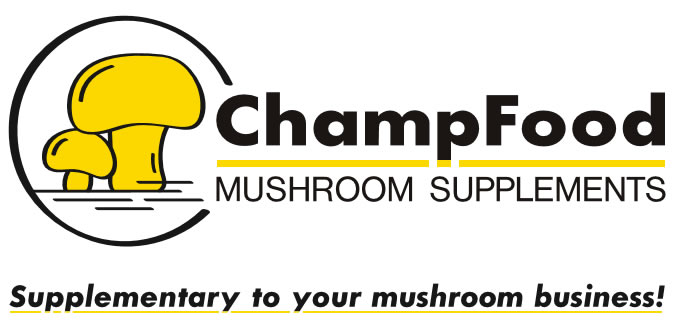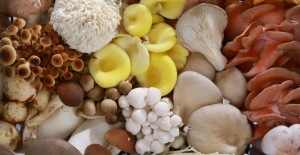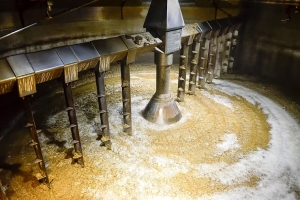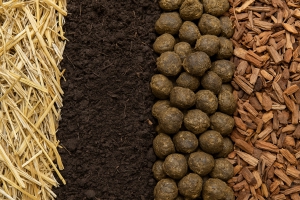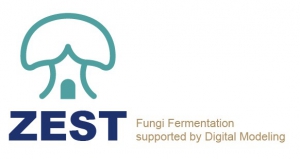
Mushroom Matter
Welcome on our platform. Why MUSHROOM MATTER? Because mushrooms play an important role in our lives as well in business. Our goal is to bring the world the very latest mushroom news with the upmost care to support the positioning of our beloved Mushroom.
From grower to frontrunner, the Dutch mushroom continues to grow
What once started in the 1950s with a smart combination of horticultural knowledge and a rock-solid infrastructure, has grown into a sector that now sets the tone in Europe: the Dutch mushroom industry. But the success story does not stop there. On the contrary, the sector is transforming at a rapid pace.
The smell of freshly picked mushrooms no longer betrays the whole story. Behind the scenes, the world of mushrooms has grown into a domain of innovation, sustainability and smart technology. It is no longer just about production; it is about value. About applications that go beyond the plate, and play a role in health, food innovation and circular processes.
Two men who experience this development up close are Rob Banken of Banken Champignons Groep and Jan Klerken Jr. of Scelta Mushrooms. As part of the European campaign ‘European mushrooms, hidden gems’, they talk about a sector in motion. A sector that knows its roots, but is not afraid to break new ground. “We build on decades of experience, but we are constantly looking ahead,” says Klerken Jr. “Sustainability and technological innovation go hand in hand with us.”
The Netherlands is considered an undisputed leader in Europe, and that is no coincidence. The shift from mass production to advanced applications is the result of years of investment, in people, machines and methods. Banken adds: “The strength of the Dutch sector lies in cooperation and in the willingness to innovate. That makes us flexible and future-proof.”
The mushroom as a hidden gem? In the Netherlands, it is increasingly coming into the spotlight, as a flavouring and as a symbol of progress.
Find a more extensive news item by EVmi here (in Dutch).
The Department of Trade and Industry (DTI) Guimaras has launched its first Shared Service Facility (SSF) of 2025, aimed at boosting mushroom processing capabilities for the Avila Farmers Agrarian Reform Cooperative (AFARCO) in Brgy. Avila, Buenavista, Guimaras.
The ceremonial turnover of the facility on June 23 was led by DTI Guimaras Officer-in-Charge Juvy Benliro, alongside Vice Mayor Cyril Beltran, Brgy. Captain Aster Brian Hiponia, AFARCO Chairman Alfredo Ferrer, Business Manager Teresita Martinez, and members of the cooperative.
The SSF includes specialized food-grade machinery for cleaning, slicing, dehydrating, and packaging oyster mushrooms, designed to improve productivity and maintain consistent product quality.
Please read the full article here.
Source: DailyGuardian
On the photo:
Key stakeholders, members of the AFARCO Cooperative, together with the technical and support staff of DTI Guimaras during the official launching of the Shared Service Facility (SSF) on Mushroom Processing.
Distilleries produce more than just spirits. In Kentucky—home to 95% of the world’s bourbon—booming production has led to a surge in byproducts, particularly stillage: a nutrient-rich slurry of spent grains and moisture left after distillation. Traditionally used as animal feed or disposed of via wastewater systems, stillage is now gaining attention as a promising input for bio-based materials.
A recent study from the University of Kentucky published in Fungal Biology and Biotechnology, explores how this overlooked waste stream can be transformed into pure mycelium materials (PMM) using solid-state fermentation. By feeding stillage solids to fast-growing fungi like Rhizopus oligosporus, researchers were able to produce tunable, leather-like sheets of aerial mycelium. The process not only valorises distillery byproducts but also opens up new avenues for sustainable material production at scale.
Fast-Growing Fungi, Flexible Materials Most commercial mycelium materials are made using Basidiomycota fungi such as Pleurotus ostreatus, known for their ease of cultivation and controllable growth. But the Kentucky study tested R. oligosporus, a Mucoromycota species used in tempeh fermentation. Its advantage? Speed. The fungus grew up to four times faster than P. ostreatus, producing dense mats of mycelium in just three to five days under controlled conditions. The team focused on growing aerial mycelium—the fluffy, thread-like structures that rise above the substrate. These fibres can be harvested and processed into flexible, leather-like sheets. Their quality and structure depended on several factors: substrate packing density, support height, and nutrient composition.
Please read the full article here.
Source: MycoStories
Photo: Depositi photos
The recent shortage of straw and hay in parts of North America and Europe has sparked a flurry of questions regarding what can be used as a substitute for compost ingredients. We thought a quick review of materials listed by Dr. Lee Schisler at the North America Mushroom Conference in the 80s and other materials that may be available around North America and elsewhere would be of some interest. There may be materials that we are not discussing that could be used as compost ingredients, but most likely in areas where better materials are not readily available.
Bulk Ingredients
Straw, whether it be straight wheat straw or bedded horse-manure straw, is the most common bulk ingredient used around the world. Other varieties like barley and rye can be used, although composting practices will need to be modified for these types of straw. The nitrogen, cellulose, hemicellulose, and lignin content of these straws may vary based on the variety, but differences are probably more related to where and how it is grown. Rice straw, although used in SE Asia, is generally not a desirable material as it is physically short, tough, and hard to break down. Oat straw is also a poor material; as it composts, it quickly becomes flat and soft, contributing to anaerobic conditions. Sorghum and sugar cane fodder can be used, but the stalks should be physically crushed before starting the composting process.
Corn fodder is starting to be used; our research has suggested 25% might be the most one could add to a straw-hay formula without negatively influencing yields. Its structure may also limit its use in systems that do not physically chop the fodder. In Pennsylvania and parts of Canada, mulch hay is a common bulk ingredient, timothy and orchard grasses being the most common varieties. Alfalfa can be used, but it is higher in N and physically can be more challenging to compost. Generally, in hay-based formulas, other bulk ingredients are used to provide additional carbohydrates to the formula. These bulk ingredients include corn cobs (ground or pelletized), cottonseed hulls (as is or pelletized). Less common are items such as hardwood bark or chips; deciduous leaves are used seasonally at one progressive farm, but the collection and storage of this material are challenging. Potato peel and slicer waste has been reported to be an option, but it is probably not commonly used because of problems associated with handling and storage of these high-moisture materials.
Other bulk ingredients that have been tried include peanut and rice hulls, but they are very high in lignin and hard to break down in the short composting times found at most commercial farms. Softwood barks have compounds (phenolic?) toxic to Phase 2 microbes and mushroom mycelium. Kenaf core, a by-product of the fiber collection process, and recycled paper wastes are possible ingredients, but at low amounts, say no more than 5-10% of the total volume. Additional research should be conducted, as paper waste is much different today than when this work was first reported in the 1970s. At this time, we consider spent mushroom compost as a filler material with no useable nutrients or used as an avenue to dispose of small quantities; however, research is being done to determine if larger quantities can be used as a bulk ingredient or as a supplement. Mushroom stumps are often disposed of in compost, but add little to the value of the compost.
Supplements
The “inorganic” sources of nitrogen, those with no carbohydrates, are historically used in synthetic formulas only and at no more than 25 lbs. per dry ton of other ingredients. The most common and only one still readily available is urea, often used with straight wheat straw formulas as a starter ingredient to “soften” the straw early in the pre-conditioning process. Calcium Cyanamid has been reported to be a substitute but must be pH adjusted and is not a commonly available ingredient, and hence not widely used. These inorganic supplements need to be added early in the composting process and are not readily available to the Phase II microbes.
More “organic” supplements, ones with carbohydrates readily available, are valuable but more expensive and therefore generally used later in the composting process to ensure there is a balanced formula. These ingredients include more common materials such as brewer’s and or distiller’s grain, cocoa bean hulls (contain an oil that microbes like), cottonseed meal, bedded poultry manure, ground soybean, rapeseed screenings, and sugar cane bagasse. Poultry manure for broilers is most common, but layer poultry manure, dried and processed, may also be used. The nitrogen content of poultry manure may vary depending on the source, number of flocks bedded on it, and other factors, so it is suggested to analyze the N content on a regular basis. Liquid poultry manure is used in some tunnel facilities that are designed to handle it. Rapeseed oil meal (expeller or solvent) or screenings are more likely to be available in the northern states and in Canada.
Other not so common supplements would be brewers dried yeast, buckwheat millings, castor bean meal, corn gluten feed (include bran), corn gluten meal, feather meal, fish solubles, linseed oil meal (Flax seed), malt sprouts, peanut oil meal, safflower oil meal (expeller or solvent), sesame oil meal (expeller or solvent), single cell protein, soybean screenings, soybean oil meal (expeller or solvent), cocoa hulls, sugar beet pulp (source of carbon), sunflower oil meal (expeller or solvent), wheat bran, wheat germ meal, and wheat mill run. Feather meal is high in N, so it is important to have a good distribution in the mixing. Fish solubles are high in moisture and difficult to handle.
Other feedlot manures can be used if generously bedded on straw with an effective pre-conditioning period, although I know of a small hobbyist grower who was composting straight cow manure (no straw) and successfully growing mushrooms. Blood meal has nitrogen, but in a form that has very little available to the microbes in Phase II. Apple pumice and paunch are too acidic and easily go anaerobic; therefore, they would not be adding desirable characteristics to the formula.
As you can see, there is a wide variety of raw materials available, and it is up to each of you to decide what works. What works in one part of the world, or at one farm, might not necessarily work in a different system. Material availability and economics will also play an important role in deciding what raw materials work for you.
In Memoriam - Bart Driessen
We were saddened to hear of the passing of Bart Driessen, a well-known and respected figure in the international mushroom industry.
With decades of experience and a broad knowledge of composting, casing, growing and harvesting, Bart played an important role in advancing mushroom production worldwide. Through his company Mycosupport and earlier work at Sylvan, Sjaak Verdellen Consulting and Hoeijmakers Mushrooms, he supported many growers with his expertise and practical approach.
Bart will be remembered as a passionate professional who generously shared his knowledge. His impact on the sector will not be forgotten.
We extend our sincere condolences to his family, friends and all who knew him.
Fungi fermentation supported by digital modeling
Zest Project: transforming food waste into sustainable mycoprotein with AI
The Zest Project, a €7.5 million EU-funded initiative led by the Danish Technological Institute (DTI), is pioneering a sustainable approach to protein production by converting food waste into mycoprotein using mushroom fermentation and artificial intelligence .
Key Highlights:
- Innovative Fermentation Process: Utilizing edible mushroom strains, the project ferments agricultural byproducts—such as sugar beet residues, spent brewer’s grain, and fruit peels—in specially designed bioreactors. This process yields mycoprotein, chitin, and other valuable bio-based materials suitable for food, nutraceuticals, cosmetics, and packaging applications.
- AI-Driven Optimization: Advanced machine learning models monitor and adjust fermentation parameters like temperature, pH, and oxygen levels in real-time. This ensures optimal growth conditions, enhances yield and quality, and minimizes waste and energy consumption.
- Sustainability and Efficiency: The method boasts a lower environmental footprint, requiring less water and emitting fewer greenhouse gases compared to traditional protein production. Additionally, mycoprotein offers nutritional benefits, including high digestibility and essential vitamins like B12 and D.
- Circular Economy Contribution: By valorizing agricultural sidestreams, the project not only reduces waste but also lowers production costs, making sustainable protein more accessible to consumers.
For a deeper dive into how the Zest Project is reshaping sustainable protein production, please visite their website here.
A-Pit transfers activities to Mush Comb
Objective is to transition existing A-Pit customers to Mush Comb
Starting January 1, 2025, Mush Comb will, for a period of two years, share responsibility with A-Pit for service and support to A-Pit’s customer base. During this period, Dré Lenders, owner of A-Pit, will remain fully involved. As of January 1, 2027, Lenders will fully step down from his duties.
Over these two years, there will be a gradual transfer of customers. Together, both companies will ensure a smooth transition of relationships, activities, and knowledge. “The main reason for this collaboration is to guarantee continued service to my customers at all times,” says Lenders. Existing orders will remain under A-Pit’s management.
Company information
Mush Comb is an innovative company with a mission to support our mushroom, exotic crop, and compost customers by providing related products, knowledge, and services such as machinery, climate control, supplies, and engineering. Customers should choose us for our deep knowledge of the market and because we don’t treat you like a number – but as our number one!
For questions or more information, please contact:
Bob Holtermans,
Directeur Mush Comb
This email address is being protected from spambots. You need JavaScript enabled to view it.
Tel: 077 398 3929
www.mushcomb.com
Virus and bacterial diseases
LaFrance virus disease
Of all the diseases confronting mushroom growers, none have been the subject of more confusion than viral diseases. Viral diseases can be confused with the effect of poor cultural practices or the bacterial disease mummy. Since no known commercial mushroom strain is resistant to viruses, growers must incorporate preventive measures into the IPM plan and rigorously carry out control measures.
The virus lives in mushroom spores and mycelium (spawn). Infected spores spread the disease to other new crops. Infected mycelium (spawn) may survive in the bed boards or quickly spread in bulk phase III facilities. Spores survive many years and can be released during farm renovations.
Symptoms (Figure 1-4):
- Portabellas don’t size up; lower yield, Fig 1.
- Bare areas with few pins and mushrooms, Fig 2.
- Premature opening of the veil (small caps)
- Mild yield loss
Severe infection:
- “Drumstick” (small caps, long stems) Fig 3.
- Weak growth in the casing that often disappears over time
- Die-back of mycelium in the compost, Fig 4.
- Stems discolor quickly when cut
- Significant yield loss
Control:
- Exclude, eradicate, or reduce inoculum.
- Mushroom spores at spawning
- Mushrooms should be harvested before they mature and the caps open, releasing spores.
- Infected mycelium at spawning or casing
- Isolate the crop.
- Regularly scheduled replacement of filters/filtration
- Air movement—high positive pressure in spawning and casing areas
- Practice postharvest steaming to eliminate pathogens and mushroom mycelium/spores between crops.
- Virus-infected mycelium in the wooden tray/bed boards
- Virus-infected mushrooms and spores left on the bed
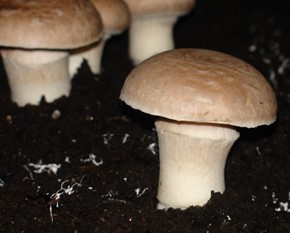 figure 1 |
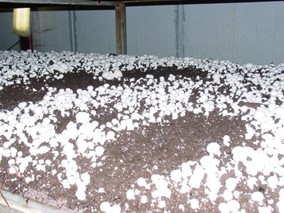 figure 2 |
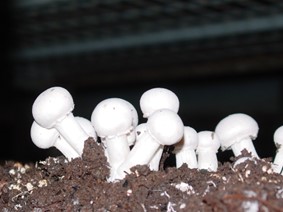 figure 3 |
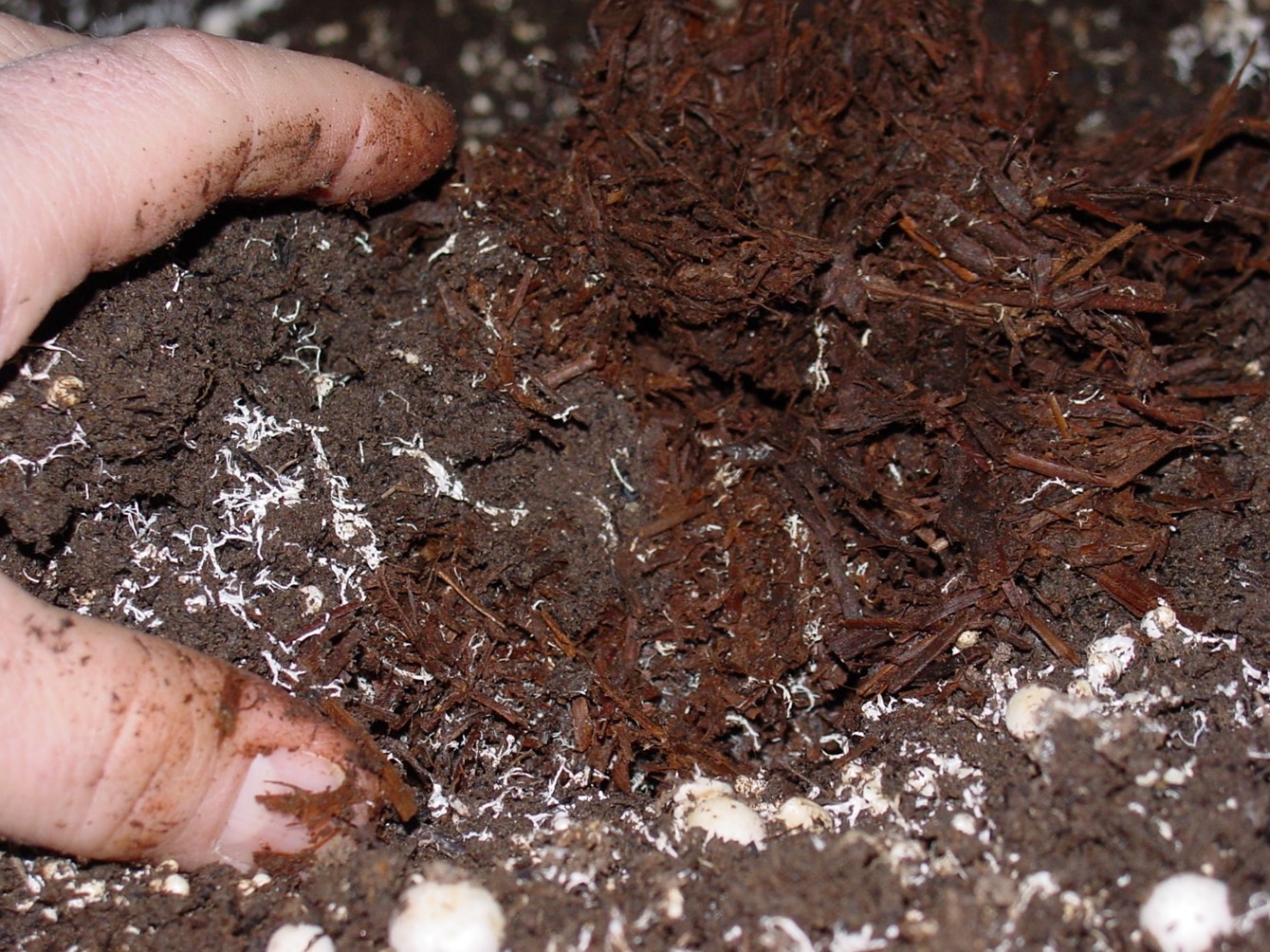 figure 4 |
Bacterial diseases
1) Bacterial Blotch
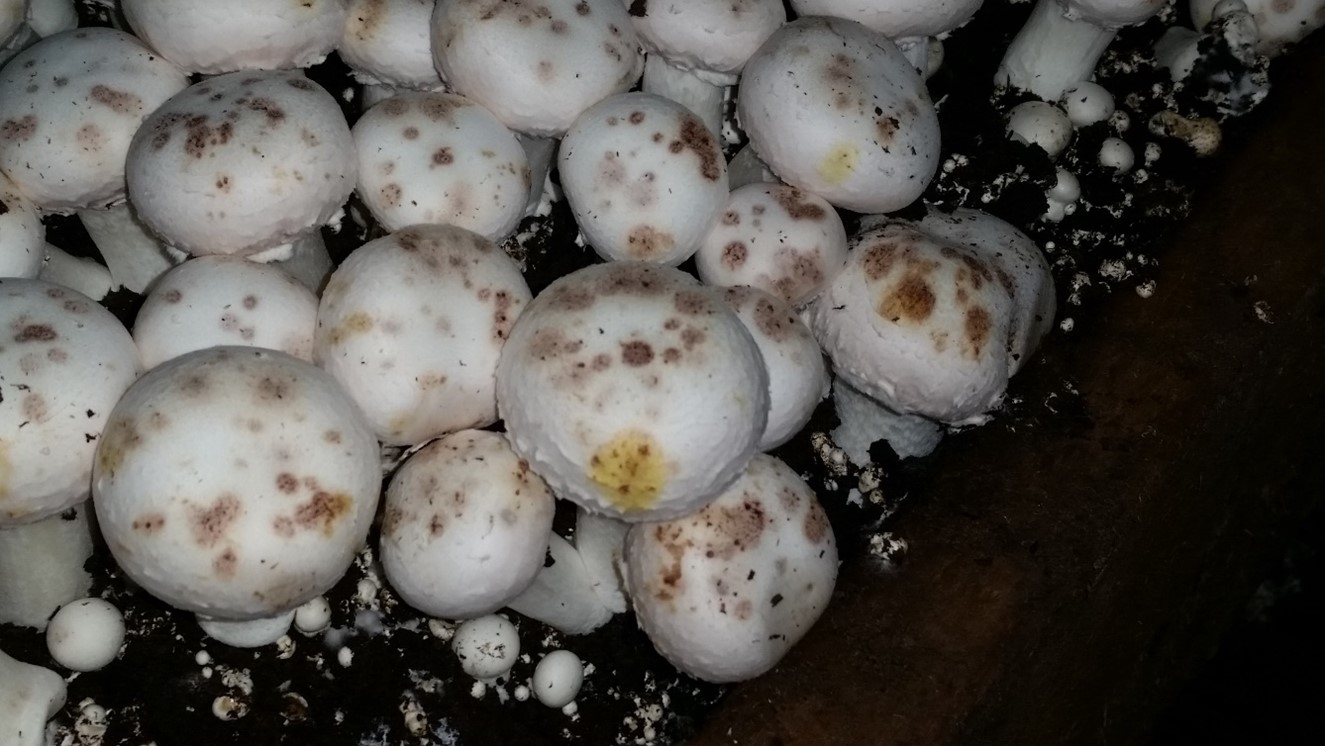
Signs and Symptoms:
- Superficial discoloration which leads to lower quality in the marketplace
- First pale yellow, then darkens to golden yellow to brown color.
- Bacterial pathogen: Pseudomonas tolaasii, recently other species have been found to cause similar symptoms
2) Mummy Disease

Signs and Symptoms:
- Stunted growth, swollen base
- Sometimes mushrooms develop curved stipe with translucent, longitudinal streaks on the side
- Tissue appearance: spongy, dry and leathery
- First break can be harvested; second break mushroom does not grow in the affected area
- Scientific name: Pseudomonas species
By David M. Beyer, Penn State University


